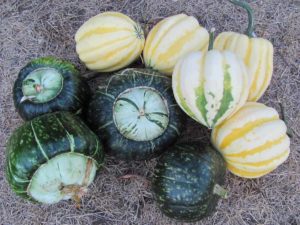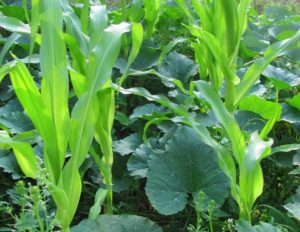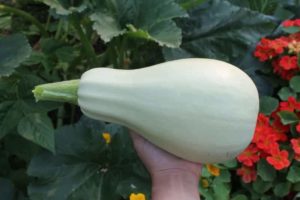The spaghetti squash plant is scientifically called Cucurbita pepo, but gardeners began referring to it as spaghetti squash due to its spaghetti-like appearance when cooked.
Spaghetti squash is often used as a healthy pasta substitute in gluten-free recipes, as its fibers are so long and meaty that you can twirl them around your fork during your meal.
This vegetable doesn’t taste like spaghetti at all and has more of a smooth and nutty flavor that goes well with rich cream sauces and soft cheese.

| Scientific Name | Cucurbita pepo |
| Common Names | Vegetable spaghetti, vegetable marrow, or noodle squash |
| Hardiness | Easy to grow |
| Indoor or Outdoor Plant? | Indoor and outdoor plant, although it will grow best outside in full sun |
| Sun Exposure | Full sun |
| Water | They require an inch or two of water every week |
| Size | Will weigh between two to five pounds |
| Soil Type | Loose, well-drained soil |
| Soil pH | 6.0 to 6.8 |
| Flower | Bright yellow star-shaped flowers |
| Growing Difficulty Level | Easy to grow if the weather conditions are appropriate for the plant |
Spaghetti Squash Appearance and Characteristics
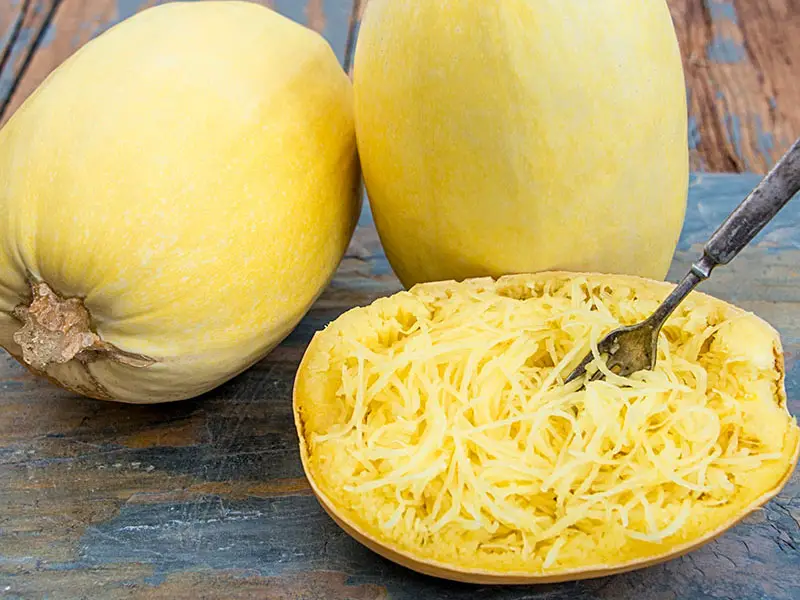
The spaghetti squash is a vibrant golden yellow color when it is ripe. Unripe plants are green or have a pale appearance, so determining whether your squash is ready for harvest is very easy indeed.
Some spaghetti squash has a mottled appearance, which can make it difficult for people who are unfamiliar with the plant to identify it.
The stripetti squash is a hybrid of the delicata and spaghetti squash.
This plant looks a lot like the spaghetti squash but is watermelon-shaped and has beige and green horizontal stripes.
The spaghetti squash plant produces both female and male flowers that are pollinated by bees.
These flowers are star-shaped and small, and they too are a bright golden yellow color.
In order for your flowers to get pollinated, you will need to have at least four or more healthy plants growing nearby.
Growing summer squash near the spaghetti squash plants will increase pollen supply.
Advantages of Growing Spaghetti Squash

There are many health benefits to growing spaghetti squash in your vegetable garden.
Incorporating spaghetti squash into your diet will boost your vitamin C intake, how much dietary fiber you consume, as well as being a brilliant source of niacin, vitamin B6, pantothenic acid, potassium, and manganese.
Other than the brilliant health benefits that eating spaghetti squash will give you, there aren’t any out-of-the-ordinary biological benefits of growing the plant.
The great news is that if you have lots of vegetables and flowers growing in your garden, they will attract bees and other wildlife to your garden, which is a delightful sight to observe.
Spaghetti Squash Growing Guide
Although the spaghetti squash plant is easy to grow, sticking to a growing guide is important.
Use the information in the following section to put together a squash maintenance schedule to ensure the spaghetti squash in your garden stay healthy.
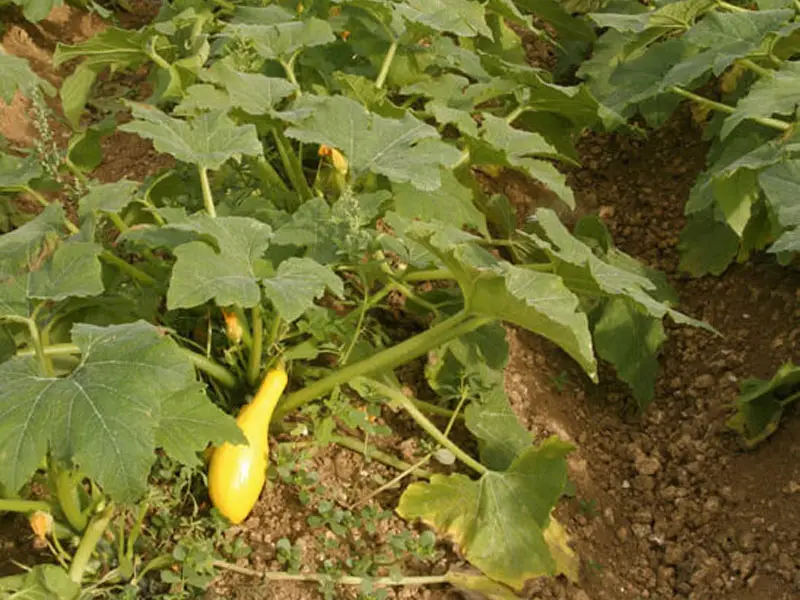
Water
On average, spaghetti squash plants that grow in their ideal climate will require between one and a half to two inches of water weekly.
Plants that are growing in very dry conditions will need to be watered more frequently to ensure the plant is getting plenty of water.
Drip irrigation systems are great for watering spaghetti squash plants and will result in the best root and plant health.
This isn’t always possible, and in that case, if you are watering the plant with a hose, be sure not to overwater it.
Light
Spaghetti squash plants are summer vegetables.
They need to be planted in an area of the garden that gets plenty of natural sunlight, and full sun is the best for these plants.
Soil
In order for your spaghetti squash plant to grow well, you should use well-drained soil with plenty of nutrients.
Mixing organic matter into the soil is highly recommended before planting new squash plants.
Ideally, the top three inches of soil should be mixed with compost or aged manure before a new squash plant is planted.
You may want to add compost to the soil throughout the growing season too if the plant needs an added boost.
Temperature and Humidity
The most important thing to remember is that spaghetti squash plants are heat tolerant, and very susceptible to frost damage.
Your plant may become damaged from very light frost between 28º F to 32º F, so getting your planting times right is crucial.
Plant new spaghetti squash plants when the temperature outside is 65º F or higher. This will result in the most successful harvest and the least amount of problems.
Extreme humidity is never ideal and will result in the plants needing more tender loving care to prevent diseases and insect infestations.
Growing spaghetti squash in extremely humid areas such as Florida can be challenging, but greenhouses and other solutions should help you manage the humidity levels around the plants.
Potting and Re-Potting
Spaghetti squash plants can be grown directly in the soil or in pots.
Here are some tips and tricks, along with a step-by-step guide for planting spaghetti squash successfully.
Tools You Will Need:
- 3-inch pots
- Potting soil
- Plastic covering or heating pad
- Organic compost or well-rotted manure
- Trellis with extra support
- Cotton fabric or pantyhose
- Sharp knife
Top Tip: Gather all of your equipment before you start your squash planting project to avoid hiccups and delays along the way.
Start Seeds Before the Last Frost Date
Growing squash from seedlings is very different from growing squash from cuttings.
Seeds need to be started and sown before the last frost date, whereas newly planted squash plants should only be potted after the last frost date.
This is why proper planning and organization are key to your plant’s success.
Fill three-inch pots up with potting soil and plant four seeds in each pot an inch deep. Cover the seeds with soil and water generously.
Place the Seeds in a Warm, Sunny Place
Choose a warm spot in your home that gets plenty of sunlight and place the sown seeds in the desired location.
Windowsills are great sunspots for new seeds. Either cover the soil in plastic or place the seeds on a heating pad set too low to encourage them to germinate.
Keep the Soil Moist Until they are Ready to be Transplanted
The soil should stay moist consistently until the seeds are ready for transplanting.
The seeds are ready once the plant has grown several strong leaves.
Prepare the Soil for Planting Outdoors
Once the seeds are ready to be transplanted, you will need to prepare the soil outside.
To do this, turn and mix the soil with three inches of organic matter so that the soil is super fertile.
Compost and well-rotted manure are brilliant for adding nutrients to the ground.
Secure the Trellis
If you haven’t already got a garden trellis, building one will greatly help you.
Make sure that the trellis is secure and can handle the weight of the growing vines and fruit.
Plant the Squash
Once the outdoor space is ready, it is time to plant the squash seedlings outside. This should only be done after the last chances of frost have passed.
Allow three plants per hill along the trellis. Remember, overcrowding the trellis will cause problems down the road.
Water Weekly
The plants need to be watered once or twice weekly. The volume of water they require highly depends on the weather conditions and heat they are growing in.
Unless the plants are growing in drought conditions, they will only need between one and two inches of water every week.
Guide the Vine onto the Trellis
As the vine grows, it will need to be guided and supported along the trellis. This can be done by twisting it around the trellis or securing the vines in place gently using wire.
-
- Support the Squash if Needed
Once the plant is well established and growing well, you will start to notice the spaghetti squash growing on the vine.
These vegetables will weigh about five pounds when they are ripe and ready for harvesting, so measures should be put in place to support the squash and stop it from falling off the plant prematurely.
Propagating and Pruning
Pruning the spaghetti squash vine just before the end of the season will encourage the plant to ripen its fruits.
This can be done by cutting the top of the vine in late August.
Most squash plants are propagated by seeds. Propagating the plant from cuttings is possible but not advised.
Spaghetti Squash Pests, Diseases, and Problems
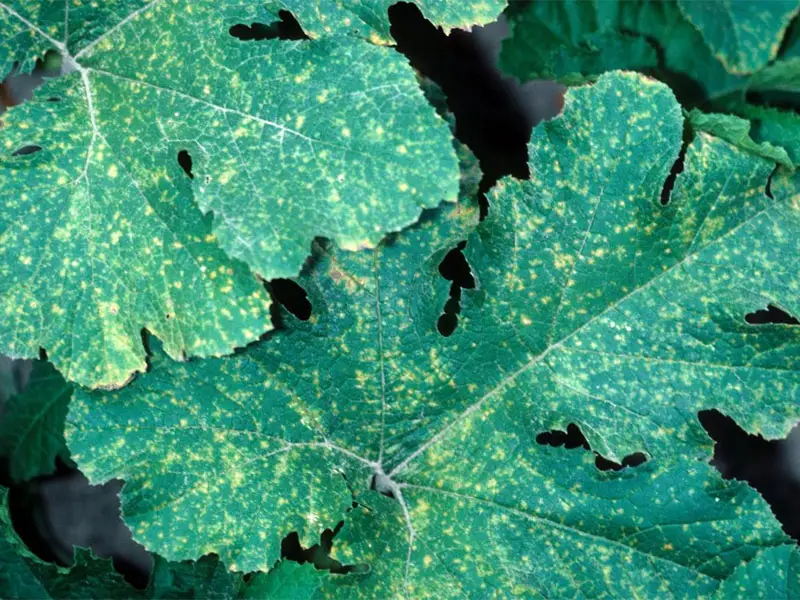
Powdery mildew, downy mildew, and bacterial wilt are common problems affecting the spaghetti squash plant; however, these can be easily avoided with the right care.
Avoiding overwatering the plant and keeping their growing space well aerated and dry will keep the plants healthy.
Protecting immature plants with floating row covers is recommended to stop beetles, squash bugs, and vine borers from attacking the plant.
Check the underside of the plant leaves for eggs, and if any are found, remove and crush them by hand.
Finding Spaghetti Squash Seeds
Using high-quality seeds is important if you want a high seed germination rate.
Here are some links to reliable seed distributors if you are on the hunt for quality spaghetti squash seeds:
Gardeners Basics Store Seeds

Ohio Heirloom Seed Store

FAQs
How long does it take spaghetti squash to mature?
Spaghetti squash takes between 90 to 100 days to mature. This plant is difficult to grow in cool areas with a short summer because of how long it takes to harvest.
When should I eat spaghetti squash?
Good spaghetti squash is firm to touch and vibrant. If the squash feels very moist or soft and has turned a dull color or black, then it has probably gone bad.
What month should I plant spaghetti squash?
Spaghetti squash should be planted after the last frost has passed.
The exact date will vary from area to area.
When growing spaghetti squash from seeds, the seeds should be sown a few weeks before the last frost so that the seedlings can develop, ready to be transplanted in spring.
How many spaghetti squash fruit should I expect my plant to produce?
On average, spaghetti squash vines produce between three to five fruit.
Planting more than one plant is advised for the best harvest, and this is usually doable and convenient when using a trellis.
How big should spaghetti squash be before picking?
Spaghetti squash will weigh anything between two to five pounds when ripe and ready.
Look at the color of the squash to determine whether the vegetable is ready for harvesting or not.
Plants that are struggling to ripen their fruit can be pruned to help the plant focus its energy on ripening the fruit. This is a common farming trick used worldwide.
Will my spaghetti squash plant survive the frost?
No, spaghetti squash plants are sensitive to cold weather and will become damaged and can die from the lightest frosts.
This is why proper planning and preparation are required to ensure the plant is not exposed to unideal growing conditions before harvest.
Why isn’t my spaghetti squash growing?
Growing problems are usually associated with pests, diseases, and soil issues.
Identifying the problem with a squash plant can be tricky if the plant looks healthy, but performing a close inspection of the plant and soil should give an indication of the problem.
Mildew, root rot, overwatering, and the wrong soil type are the most common plant issues.
Check for these and signs of pest infestations before concluding the problem. Performing a weekly check should also stop any plant issues before they become hard to handle.
Is the spaghetti squash plant right for your garden? Let us know what your experiences are of growing the plant and what helped you produce a fruitful harvest. Any tips, tricks, and advice are greatly appreciated!




